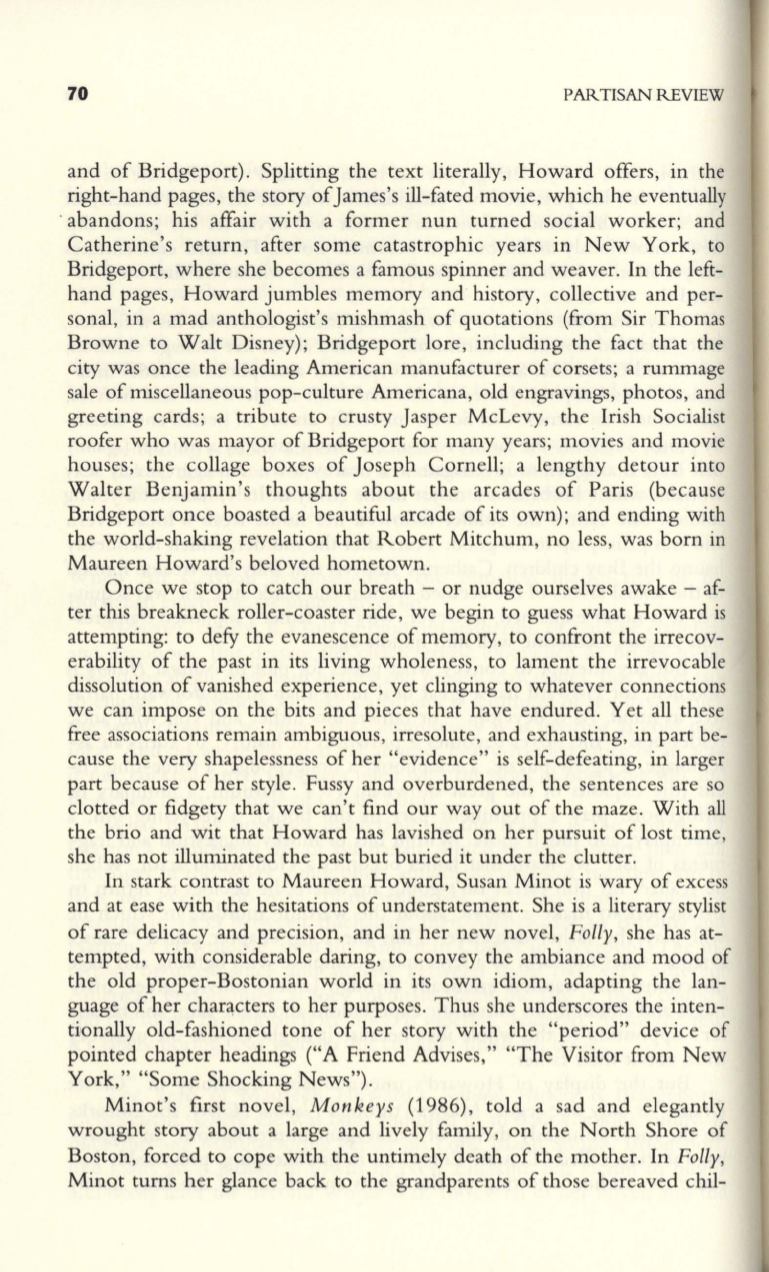
70
PARTISAN REVIEW
and of Bridgeport). Splitting the text literally, Howard offers, in the
right-hand pages, the story ofJames's ill-fated movie, which he eventually
. abandons; his affair with a former nun turned social worker; and
Catherine's return, after some catastrophic years in New York, to
Bridgeport, where she becomes a famous spinner and weaver. In the left–
hand pages, Howard jumbles memory and history, collective and per–
sonal, in a mad anthologist's mishmash of quotations (from Sir Thomas
Browne to Walt Disney); Bridgeport lore, including the fact that the
city was once the leading American manufacturer of corsets; a rummage
sale of miscellaneous pop-culture Americana, old engravings, photos, and
greeting cards; a tribute to crusty Jasper McLevy, the Irish Socialist
roofer who was mayor of Bridgeport for many years; movies and movie
houses; the collage boxes of Joseph Cornell; a lengthy detour into
Walter Benjamin's thoughts about the arcades of Paris (because
Bridgeport once boasted a beautiful arcade of its own); and ending with
the world-shaking revelation that Robert Mitchum, no less, was born in
Maureen Howard's beloved hometown.
Once we stop to catch our breath - or nudge ourselves awake - af–
ter this breakneck roller-coaster ride, we begin to guess what Howard is
attempting: to defy the evanescence of memory, to confront the irrecov–
erability of the past in its living wholeness, to lament the irrevocable
dissolution of vanished experience, yet clinging to whatever connections
we can impose on the bits and pieces that have endured. Yet
all
these
free associations remain ambiguous, irresolute, and exhausting, in part be–
cause the very shapelessness of her "evidence" is self-defeating, in larger
part because of her style. Fussy and overburdened, the sentences are so
clotted or fidgety that we can't find our way out of the maze. With all
the brio and wit that Howard has lavished on her pursuit of lost time,
she has not illuminated the past but buried it under the clutter.
In stark contrast to Maureen Howard, Susan Minot is wary of excess
and at ease with the hesitations of understatement. She is a literary stylist
of rare delicacy and precision, and in her new novel,
Folly,
she has at–
tempted, with considerable daring, to convey the ambiance and mood of
the old proper-Bostonian world in its own idiom, adapting the lan–
guage of her characters to her purposes. Thus she underscores the inten–
tionally old-fashioned tone of her story with the "period" device of
pointed chapter headings ("A Friend Advises," "The Visitor from New
York," "Some Shocking News").
Minot's first novel,
Monkeys
(1986), told a sad and elegantly
wrought story about a large and lively family, on the North Shore of
Boston, forced to cope with the untimely death of the mother. In
Folly,
Minot turns her glance back to the grandparents of those bereaved chil-


